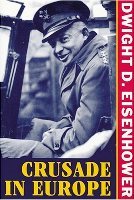
Crusade in Europe is General Dwight David Eisenhower's memoir from the early days of World War II through the early post-war. His story and observations are crucial to an understanding of the Great Crusade. Among memoirs, this is a gem.
General Eisenhower takes the reader along with him through each stage of the Crusade. Having attracted attention for his performance in Army maneuvers in Louisiana in 1940, General Eisenhower was called to Washington immediately after Pearl Harbor because of his recent experience in the Philippines. He was first assigned to work on plans for the Pacific. At this point the reader is reminded that, in contrast to the later Germany First Policy, the American public, for a time, screamed for revenge on Japan before dealing with Germany.
Assigned to command Operation Torch, the invasion of French North Africa in 1942, General Eisenhower was charged with obtaining Allied Cooperation. He was plunged into the quagmire of French politics. The disappointing involvement with General Giraud presented an intra-allied problem, as did cooperation of Admiral Darlan, who while too helpful to rebuff, brought with him the stigma of association with a collaborator. The age-old Arab-Jewish hostility further complicated the administration of the liberated territory.
With North Africa cleared out, General Eisenhower was charged with the conquest of Sicily. Management of the Patton-Montgomery rivalry was a major challenge of the campaign. Success having been achieved, the Patton slapping incident in Sicily forced General Eisenhower to reprimand a close friend while threatening to deprive him of one of his most effective Army commanders.
Speculation that General Eisenhower would return to the Washington as Chief Of Staff while General Marshall commanded Overlord, the invasion of Europe, distracted General Eisenhower's attention from problems at hand. General Eisenhower's eventual appointment to command Overlord forced him to leave the Mediterranean while the Italian campaign was still in doubt. Upon arrival in England he immediately switched gears to plan the size, timing, supply and location of the invasion of France.
With the invasion ashore, General Eisenhower skillfully managed his coalition of impetuous commanders in their march across Europe. General Eisenhower brings the reader into the thought processes and conferences leading to decisions on the liberation of Paris, Operation Market-Garden, and the Battle of The Bulge.
Americans are familiar with Patton's claim that, with supplies, he could capture Berlin and win the war. General Eisenhower relates that Monty bothered him with similarly impractical suggestions. He then explains why the proposals were doomed to failure. Spirited arguments with the British over Project Anvil (Invasion of Southern France) come within the reader's vision through General Eisenhower's eyes.
The greatest criticism of General Eisenhower's wartime leadership is reserved for questions about whether the Western Allies should have advanced further to limit the Red Army's area of occupation. General Eisenhower assesses the claims and presents support for his decisions.
After V-E Day, General Eisenhower's role shifted more into that of a statesman as he attempted to obtain cooperation with the Russians over the administration of occupied Germany.
Some things come clearly through the pages of this book. The reader is constantly impressed with the importance of supplies, bringing to mind the adage that "Amateurs speak of tactics, professionals speak of logistics." Despite later controversies, General Eisenhower's admiration for General George Marshall is made clear on the pages of this book. Written in 1948, I find the statement that General Eisenhower disagreed with many of FDR's domestic policies to be surprising and a hint of his later political initiatives. Crusade in Europe is written in a very clear, easy to read and follow style. It never becomes bogged down in boring details. It does not have any mention of his relationship with his female English army driver. Read by Jimmie A. Kepler in 2004.


No comments:
Post a Comment